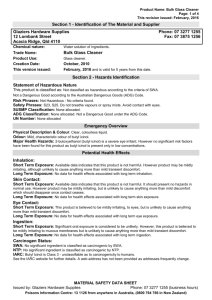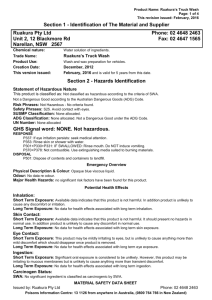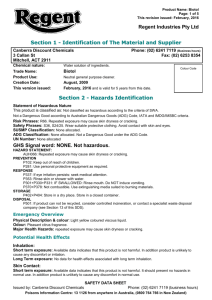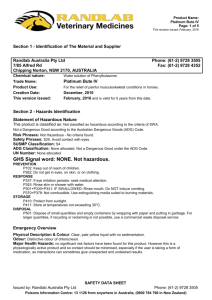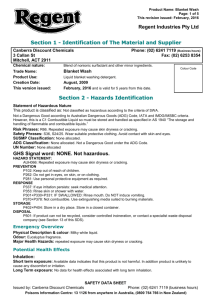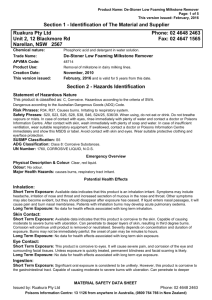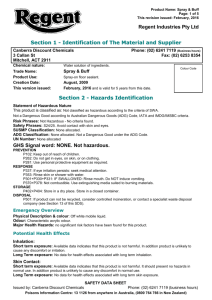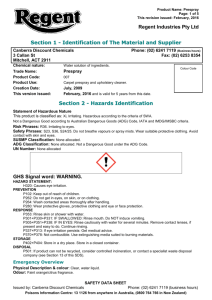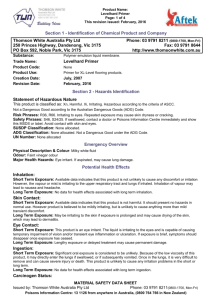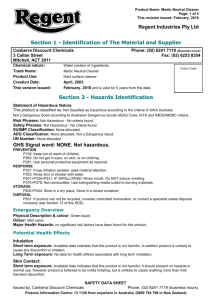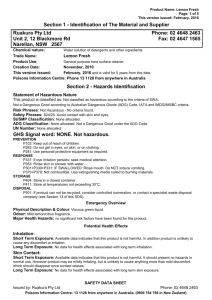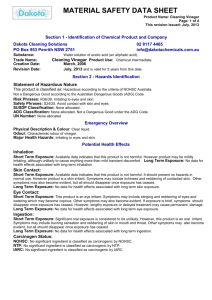Section 16 - Other Information
advertisement
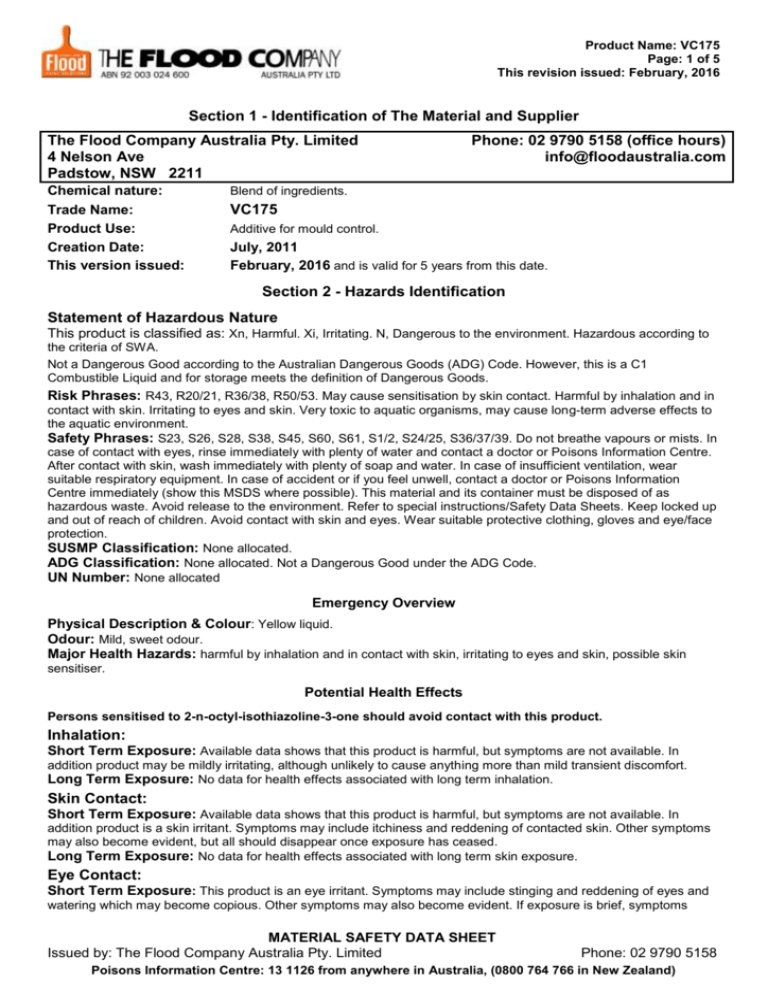
Product Name: VC175 Page: 1 of 5 This revision issued: February, 2016 Section 1 - Identification of The Material and Supplier The Flood Company Australia Pty. Limited 4 Nelson Ave Padstow, NSW 2211 Chemical nature: Blend of ingredients. Trade Name: Product Use: Creation Date: This version issued: VC175 Phone: 02 9790 5158 (office hours) info@floodaustralia.com Additive for mould control. July, 2011 February, 2016 and is valid for 5 years from this date. Section 2 - Hazards Identification Statement of Hazardous Nature This product is classified as: Xn, Harmful. Xi, Irritating. N, Dangerous to the environment. Hazardous according to the criteria of SWA. Not a Dangerous Good according to the Australian Dangerous Goods (ADG) Code. However, this is a C1 Combustible Liquid and for storage meets the definition of Dangerous Goods. Risk Phrases: R43, R20/21, R36/38, R50/53. May cause sensitisation by skin contact. Harmful by inhalation and in contact with skin. Irritating to eyes and skin. Very toxic to aquatic organisms, may cause long-term adverse effects to the aquatic environment. Safety Phrases: S23, S26, S28, S38, S45, S60, S61, S1/2, S24/25, S36/37/39. Do not breathe vapours or mists. In case of contact with eyes, rinse immediately with plenty of water and contact a doctor or Poisons Information Centre. After contact with skin, wash immediately with plenty of soap and water. In case of insufficient ventilation, wear suitable respiratory equipment. In case of accident or if you feel unwell, contact a doctor or Poisons Information Centre immediately (show this MSDS where possible). This material and its container must be disposed of as hazardous waste. Avoid release to the environment. Refer to special instructions/Safety Data Sheets. Keep locked up and out of reach of children. Avoid contact with skin and eyes. Wear suitable protective clothing, gloves and eye/face protection. SUSMP Classification: None allocated. ADG Classification: None allocated. Not a Dangerous Good under the ADG Code. UN Number: None allocated Emergency Overview Physical Description & Colour: Yellow liquid. Odour: Mild, sweet odour. Major Health Hazards: harmful by inhalation and in contact with skin, irritating to eyes and skin, possible skin sensitiser. Potential Health Effects Persons sensitised to 2-n-octyl-isothiazoline-3-one should avoid contact with this product. Inhalation: Short Term Exposure: Available data shows that this product is harmful, but symptoms are not available. In addition product may be mildly irritating, although unlikely to cause anything more than mild transient discomfort. Long Term Exposure: No data for health effects associated with long term inhalation. Skin Contact: Short Term Exposure: Available data shows that this product is harmful, but symptoms are not available. In addition product is a skin irritant. Symptoms may include itchiness and reddening of contacted skin. Other symptoms may also become evident, but all should disappear once exposure has ceased. Long Term Exposure: No data for health effects associated with long term skin exposure. Eye Contact: Short Term Exposure: This product is an eye irritant. Symptoms may include stinging and reddening of eyes and watering which may become copious. Other symptoms may also become evident. If exposure is brief, symptoms MATERIAL SAFETY DATA SHEET Issued by: The Flood Company Australia Pty. Limited Phone: 02 9790 5158 Poisons Information Centre: 13 1126 from anywhere in Australia, (0800 764 766 in New Zealand) Product Name: VC175 Page: 2 of 5 This revision issued: February, 2016 should disappear once exposure has ceased. However, lengthy exposure or delayed treatment may cause permanent damage. Long Term Exposure: No data for health effects associated with long term eye exposure. Ingestion: Short Term Exposure: Significant oral exposure is considered to be unlikely. However, this product is an oral irritant. Symptoms may include burning sensation and reddening of skin in mouth and throat. Other symptoms may also become evident, but all should disappear once exposure has ceased. Long Term Exposure: No data for health effects associated with long term ingestion. Carcinogen Status: SWA: No significant ingredient is classified as carcinogenic by SWA. NTP: No significant ingredient is classified as carcinogenic by NTP. IARC: No significant ingredient is classified as carcinogenic by IARC. Section 3 - Composition/Information on Ingredients Ingredients CAS No Conc,% TWA (mg/m3) STEL (mg/m3) isobutyric acid, monoester with 2,2,4-trimethylpentane-1,3-diol 25265-77-4 >75 not set not set 2-n-octyl-isothiazoline-3-one 26530-20-1 <10 not set not set This is a commercial product whose exact ratio of components may vary slightly. Minor quantities of other non hazardous ingredients are also possible. The SWA TWA exposure value is the average airborne concentration of a particular substance when calculated over a normal 8 hour working day for a 5 day working week. The STEL (Short Term Exposure Limit) is an exposure value that may be equalled (but should not be exceeded) for no longer than 15 minutes and should not be repeated more than 4 times per day. There should be at least 60 minutes between successive exposures at the STEL. The term "peak "is used when the TWA limit, because of the rapid action of the substance, should never be exceeded, even briefly. Section 4 - First Aid Measures General Information: You should call The Poisons Information Centre if you feel that you may have been poisoned, burned or irritated by this product. The number is 13 1126 from anywhere in Australia (0800 764 766 in New Zealand) and is available at all times. Have this MSDS with you when you call. Inhalation: If symptoms of poisoning become evident, contact a Poisons Information Centre, or call a doctor at once. Remove source of contamination or move victim to fresh air. If breathing is difficult, oxygen may be beneficial if administered by trained personnel, preferably on a doctor's advice. DO NOT allow victim to move about unnecessarily. Symptoms of pulmonary oedema can be delayed up to 48 hours after exposure. Skin Contact: Wash gently and thoroughly with warm water (use non-abrasive soap if necessary) for 10-20 minutes or until product is removed. Under running water, remove contaminated clothing, shoes and leather goods (e.g. watchbands and belts) and completely decontaminate them before reuse or discard. If irritation persists, repeat flushing and seek medical attention. Eye Contact: Immediately flush the contaminated eye(s) with lukewarm, gently flowing water for 20 minutes or until the product is removed, while holding the eyelid(s) open. Take care not to rinse contaminated water into the unaffected eye or onto the face. Obtain medical attention immediately. Take special care if exposed person is wearing contact lenses. Ingestion: If swallowed, do NOT induce vomiting. Wash mouth with water and contact a Poisons Information Centre, or call a doctor. Section 5 - Fire Fighting Measures Fire and Explosion Hazards: The major hazard in fires is usually inhalation of heated and toxic or oxygen deficient (or both), fire gases. This product is classified as a C1 combustible product. There is little risk of an explosion from this product if commercial quantities are involved in a fire. Violent steam generation or eruption may occur upon application of direct water stream on hot liquids. Fire decomposition products from this product may be toxic if inhaled. Take appropriate protective measures. Extinguishing Media: Suitable extinguishing media are carbon dioxide, dry chemical, foam, water fog. Fire Fighting: If a significant quantity of this product is involved in a fire, call the fire brigade. Cool closed, undamaged containers exposed to fire with water spray. Flash point: >100°C MATERIAL SAFETY DATA SHEET Issued by: The Flood Company Australia Pty. Limited Phone: 02 9790 5158 Poisons Information Centre: 13 1126 from anywhere in Australia, (0800 764 766 in New Zealand) Product Name: VC175 Page: 3 of 5 This revision issued: February, 2016 Upper Flammability Limit: Lower Flammability Limit: Autoignition temperature: Flammability Class: No data. No data. No data. C1 Section 6 - Accidental Release Measures Accidental release: In the event of a major spill, prevent spillage from entering drains or water courses. Wear full protective clothing including eye/face protection. All skin areas should be covered. See below under Personal Protection regarding Australian Standards relating to personal protective equipment. Suitable materials for protective clothing include Nitrile. DO NOT USE LEATHER. Eye/face protective equipment should comprise as a minimum, protective goggles. If there is a significant chance that vapours or mists are likely to build up in the cleanup area, we recommend that you use a respirator. Usually, no respirator is necessary when using this product. However, if you have any doubts consult the Australian Standard mentioned below (section 8). Otherwise, not normally necessary. Stop leak if safe to do so, and contain spill. Absorb onto sand, vermiculite or other suitable absorbent material. If spill is too large or if absorbent material is not available, try to create a dike to stop material spreading or going into drains or waterways. Sweep up and shovel or collect recoverable product into labelled containers for recycling or salvage, and dispose of promptly. Recycle containers wherever possible after careful cleaning. After spills, wash area preventing runoff from entering drains. If a significant quantity of material enters drains, advise emergency services. This material may be suitable for approved landfill. Ensure legality of disposal by consulting regulations prior to disposal. Thoroughly launder protective clothing before storage or re-use. Advise laundry of nature of contamination when sending contaminated clothing to laundry. Section 7 - Handling and Storage Handling: Keep exposure to this product to a minimum, and minimise the quantities kept in work areas. Check Section 8 of this MSDS for details of personal protective measures, and make sure that those measures are followed. The measures detailed below under "Storage" should be followed during handling in order to minimise risks to persons using the product in the workplace. Also, avoid contact or contamination of product with incompatible materials listed in Section 10. Storage: Note that this product is combustible and therefore, for Storage, meets the definition of Dangerous Goods in some states. If you store large quantities (tonnes) of such products, we suggest that you consult your state's Dangerous Goods authority in order to clarify your obligations regarding their storage. Store packages of this product in a cool place. Make sure that containers of this product are kept tightly closed. Keep containers dry and away from water. Keep containers of this product in a well ventilated area. Make sure that the product does not come into contact with substances listed under "Incompatibilities" in Section 10. Some liquid preparations settle or separate on standing and may require stirring before use. Check packaging - there may be further storage instructions on the label. Section 8 - Exposure Controls and Personal Protection The following Australian Standards will provide general advice regarding safety clothing and equipment: Respiratory equipment: AS/NZS 1715, Protective Gloves: AS 2161, Occupational Protective Clothing: AS/NZS 4501 set 2008, Industrial Eye Protection: AS1336 and AS/NZS 1337, Occupational Protective Footwear: AS/NZS2210. SWA Exposure Limits TWA (mg/m3) STEL (mg/m3) Exposure limits have not been established by SWA for any of the significant ingredients in this product. The ADI for 2-n-octyl-isothiazoline-3-one is set at 0.03mg/kg/day. The corresponding NOEL is set at 60mg/kg/day. ADI means Acceptable Daily Intake; NOEL means No-observable-effect-level. Data from Australian ADI List, March 2010. No special equipment is usually needed when occasionally handling small quantities. The following instructions are for bulk handling or where regular exposure in an occupational setting occurs without proper containment systems. Ventilation: This product should only be used in a well ventilated area. If natural ventilation is inadequate, use of a fan is suggested. Eye Protection: Protective glasses or goggles should be worn when this product is being used. Failure to protect your eyes may cause them harm. Emergency eye wash facilities are also recommended in an area close to where this product is being used. Skin Protection: If you believe you may have a sensitisation to this product or any of its declared ingredients, you should prevent skin contact by wearing impervious gloves, clothes and, preferably, apron. Make sure that all skin areas are covered. See below for suitable material types. MATERIAL SAFETY DATA SHEET Issued by: The Flood Company Australia Pty. Limited Phone: 02 9790 5158 Poisons Information Centre: 13 1126 from anywhere in Australia, (0800 764 766 in New Zealand) Product Name: VC175 Page: 4 of 5 This revision issued: February, 2016 Protective Material Types: We suggest that protective clothing be made from the following materials: nitrile. Do not use leather. Respirator: Usually, no respirator is necessary when using this product. However, if you have any doubts consult the Australian Standard mentioned above. Otherwise, not normally necessary. Eyebaths or eyewash stations and safety deluge showers should be provided near to where this product is being handled commercially. Section 9 - Physical and Chemical Properties: Physical Description & colour: Odour: Boiling Point: Freezing/Melting Point: Volatiles: Vapour Pressure: Vapour Density: Specific Gravity: Water Solubility: pH: Volatility: Odour Threshold: Evaporation Rate: Coeff Oil/water Distribution: Autoignition temp: Yellow liquid. Mild, sweet odour. >100°C at 100kPa -50°C No data. No data. No data. 0.96 Not available. No data. No data. No data. No data. No data No data. Section 10 - Stability and Reactivity Reactivity: This product is unlikely to react or decompose under normal storage conditions. However, if you have any doubts, contact the supplier for advice on shelf life properties. Conditions to Avoid: This product should be kept in a cool place, preferably below 30°C. Keep containers tightly closed. Containers should be kept dry. Keep containers and surrounding areas well ventilated. Incompatibilities: strong acids, strong bases, strong oxidising agents, amines. Fire Decomposition: Combustion forms carbon dioxide, and if incomplete, carbon monoxide and smoke. Water is also formed. May form nitrogen and its compounds, and under some circumstances, oxides of nitrogen. Occasionally hydrogen cyanide gas in reducing atmospheres. May form oxides of sulfur (sulfur dioxide is a respiratory hazard) and other sulfur compounds. Most will have a foul odour. Carbon monoxide poisoning produces headache, weakness, nausea, dizziness, confusion, dimness of vision, disturbance of judgment, and unconsciousness followed by coma and death. Polymerisation: This product will not undergo polymerisation reactions. Section 11 - Toxicological Information Local Effects: Target Organs: There is no data to hand indicating any particular target organs. 2-n-octyl-isothiazoline-3-one is Classed by SWA as a potential sensitiser by skin contact. Classification of Hazardous Ingredients Ingredient Risk Phrases 2-n-octyl-isothiazoline-3-one >=5%Conc<10%: Xn; R20/21; R36/38; R43 Isobutyric Acid, Monoester With 2,2,4-trimethylpentane-1,3-diol: LD50 Oral, Rat >3200mg/kg LC50 Inhalation, Rat = >305mg/L/4hr LD50 Dermal, Rabbit = >19,000mg/kg 2-n-octyl-isothiazoline-3-one: LD50 Oral, Rat 279mg/kg LD50 Dermal, Rabbit = >2000mg/kg 2,2,4-trimethyl-1,3-pentanediol monoisobutyrate Tests suggest that this product is not carcinogenic or mutagenic 2-n-octyl-isothiazoline-3-one: Non teratogenic MATERIAL SAFETY DATA SHEET Issued by: The Flood Company Australia Pty. Limited Phone: 02 9790 5158 Poisons Information Centre: 13 1126 from anywhere in Australia, (0800 764 766 in New Zealand) Product Name: VC175 Page: 5 of 5 This revision issued: February, 2016 Section 12 - Ecological Information Very toxic to aquatic organisms, may cause long-term adverse effects to the aquatic environment. Section 13 - Disposal Considerations Disposal: This product may be recycled if unused, or if it has not been contaminated so as to make it unsuitable for its intended use. If it has been contaminated, it may be possible to reclaim the product by filtration, distillation or some other means. If neither of these options is suitable, consider controlled incineration, or landfill. Section 14 - Transport Information ADG Code: This product is not classified as a Dangerous Good. No special transport conditions are necessary unless required by other regulations. Section 15 - Regulatory Information AICS: All of the significant ingredients in this formulation are compliant with NICNAS regulations. Section 16 - Other Information This MSDS contains only safety-related information. For other data see product literature. Acronyms: ADG Code AICS SWA CAS number Hazchem Code IARC NOS NTP R-Phrase SUSMP UN Number Australian Code for the Transport of Dangerous Goods by Road and Rail (7 th edition) Australian Inventory of Chemical Substances Safe Work Australia, formerly ASCC and NOHSC Chemical Abstracts Service Registry Number Emergency action code of numbers and letters that provide information to emergency services especially firefighters International Agency for Research on Cancer Not otherwise specified National Toxicology Program (USA) Risk Phrase Standard for the Uniform Scheduling of Medicines & Poisons United Nations Number THIS MSDS SUMMARISES OUR BEST KNOWLEDGE OF THE HEALTH AND SAFETY HAZARD INFORMATION OF THE PRODUCT AND HOW TO SAFELY HANDLE AND USE THE PRODUCT IN THE WORKPLACE. EACH USER MUST REVIEW THIS MSDS IN THE CONTEXT OF HOW THE PRODUCT WILL BE HANDLED AND USED IN THE WORKPLACE. IF CLARIFICATION OR FURTHER INFORMATION IS NEEDED TO ENSURE THAT AN APPROPRIATE RISK ASSESSMENT CAN BE MADE, THE USER SHOULD CONTACT THIS COMPANY SO WE CAN ATTEMPT TO OBTAIN ADDITIONAL INFORMATION FROM OUR SUPPLIERS OUR RESPONSIBILITY FOR PRODUCTS SOLD IS SUBJECT TO OUR STANDARD TERMS AND CONDITIONS, A COPY OF WHICH IS SENT TO OUR CUSTOMERS AND IS ALSO AVAILABLE ON REQUEST. Please read all labels carefully before using product. This MSDS is prepared in accord with the SWA document “National Code of Practice for the Preparation of Material Safety Data Sheets” 2nd Edition [NOHSC:2011(2003)] Copyright © Kilford & Kilford Pty Ltd, February, 2016. http://www.kilford.com.au/ Phone (02)9251 4532 MATERIAL SAFETY DATA SHEET Issued by: The Flood Company Australia Pty. Limited Phone: 02 9790 5158 Poisons Information Centre: 13 1126 from anywhere in Australia, (0800 764 766 in New Zealand)
